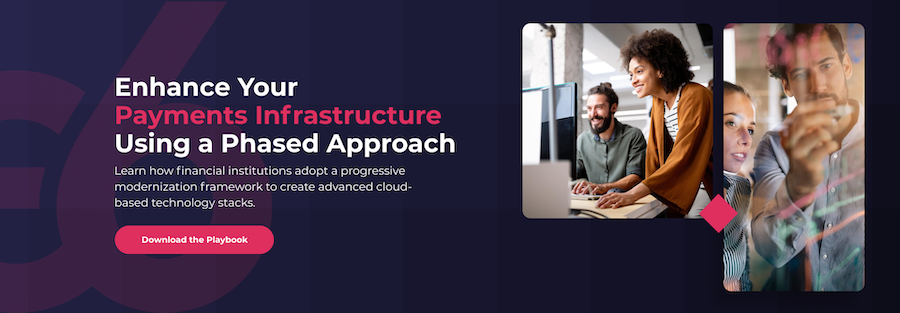5 phases of progressive modernization for shifting payment technology to the cloud

Legacy payment systems are no longer able to keep up with the digital world. Switching to a new platform may seem daunting, but when your business is left with failing payment technology, you’ll regret waiting to modernize your operating system.
The good news is that there are effective modernization programs that will enhance your payment system without delaying business operations. Progressive modernization is an innovative approach to incorporating cloud computing technology without a massive replacement of core banking systems.
Understanding the key features of this process will ensure a smooth transition to an optimized payment system for your organization, but waiting too long to begin might introduce new challenges.
Introducing progressive modernization as an approach to moving payment technology to the cloud
To improve your current payment technology, it can be risky and expensive to completely overhaul your old core banking system and replace it with a brand new one. Instead, progressive modernization offers a phased approach for slowly integrating payment systems with cloud technologies.
Some legacy systems might be working fine, but there’s a good chance that several features will not be able to keep up with the demands that come with an expanding digital landscape. Maintaining old payment systems can be costly, so finding an appropriate option to transition to will enhance your business while improving customer satisfaction.
To make the switch to a modern platform in an incremental manner, it’s critical to keep pace in mind. Transitioning too quickly can result in careless integrations, creating bigger risks in the future. On the other hand, moving systems over to cloud technology too slowly can require upgrades upon completion to keep up with an ever-evolving digital atmosphere. Progressive modernization finds the balance between careful planning and appropriate timelines.
The 5 phases of progressive modernization
Implementation of progressive modernization doesn’t happen overnight. Depending on the needs of the financial institution (FI) and the size of the system to be optimized, progressive modernization can look very different across organizations. There are a few key phases to keep in mind to ensure the success of a transition to a modern cloud environment.

Phase 1: Assessing your current payment technology setup
Before moving forward with cloud-native payment systems, it's important to first understand your current system. A cost analysis will determine where there are expenses that can be cut or replaced with advanced cloud solutions.
There are likely features that work fine, and there are others that are in need of improvement. Determining which aspects of your current payment technology system will need upgrades can be completed with assessments of data storage and user experience.
Phase 2: Mapping your legacy payment processes and systems
With an understanding of business requirements, it’s time to explore platforms for enhanced payment technology. Legacy payment stacks likely will not keep up with changing regulatory requirements, so evaluating cloud-based options will help find an appropriate solution for the best payment performance.
In this phase, it’s important to develop a clear timeline by working closely with vendors and IT team members to figure out where to place priority for optimization.
Phase 3: Designing the architecture of your cloud-based payment system
Now that a timeline has been established, it’s time to evaluate the criteria for cloud computing platforms. There are a variety of payment platforms to choose from, but an evaluation of vendors and their products will help to determine which platforms best align with your business goals.
Some questions to consider during this phase include:
- How will this platform be used as a successful tool for payment systems?
- Who will be on the IT team for the implementation of a new cloud platform?
- Will this payment system provide adequate data for business needs?
- Will the new platform be compatible with certain legacy systems that are not being optimized at this time?
Phase 4: Developing and deploying your cloud-based system
When incorporating a progressive modernization model to legacy payment stacks, it’s important to plan strategically for the future. To do so, start small and roll out upgraded features in bundles instead of all at once. This allows for FIs to test new features and determine if any changes need to be made before moving forward with the rest of their integrations.

By maintaining an evolutionary approach, FIs have the opportunity to introduce new features without affecting their business. Cloud processing or hybrid models for payment technology allow for growth and flexibility. Determining which method or a combination of integration methods provides a customized system for banks to incorporate new payment technologies.
Phase 5: Ongoing maintenance, monitoring, and updates
Progressive modernization should not be considered a one-time project. As the industry grows, the technology in place needs to be able to grow with it. Careful monitoring of the new cloud functions can provide businesses with fresh insights for areas of improvement.
This kind of modern technology also allows for consistent updates to stay ahead of the demands of the industry. With legacy systems, a new update requires an entirely new piece of hardware, which can be quite costly. Cloud-based payment stacks can quickly be optimized and maintained on-site without new equipment.
Additionally, banks must make room for new services and products that cater to today's modern society. That way banks will be much more competitive against the growing fintech crowd thanks to this openness, and they'll be more likely to meet consumer expectations and create new revenue streams.

Modernize your financial institution's tech stack with Episode Six (E6)
E6 provides financial institutions with solutions for legacy payment stacks that aren’t fulfilling the needs of an expanding industry. We are a global provider of enterprise-grade payment technology and ledger management infrastructure for banks that need to keep pace with disruptors and evolving consumer preferences.
Our PCI-compliant core platform Tritium® is 100% cloud-based and accelerates digital transformation by removing the limitations of legacy technology and enabling our customers to drive the future of payments.
Integrating payment technology with advanced cloud computing software will enhance the performance of your organization without sacrificing functionality.
The E6 team is here to assist with the progressive modernization of legacy tech stacks to improve payment processes. A well-planned and properly paced transition to new technology will limit the risks of an entirely new product installation without disrupting business processes and workflows.
To learn more about progressive modernization with E6, reach out to us today!

E6 Team
About the Author
Episode Six provides financial institutions with solutions for legacy payment stacks that aren’t fulfilling the needs of an expanding industry. We are a global provider of enterprise-grade payment technology and ledger management infrastructure for banks that need to keep pace with disruptors and evolving consumer preferences.

